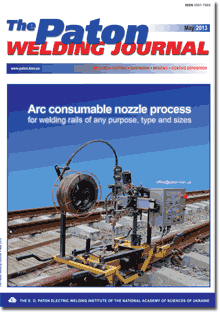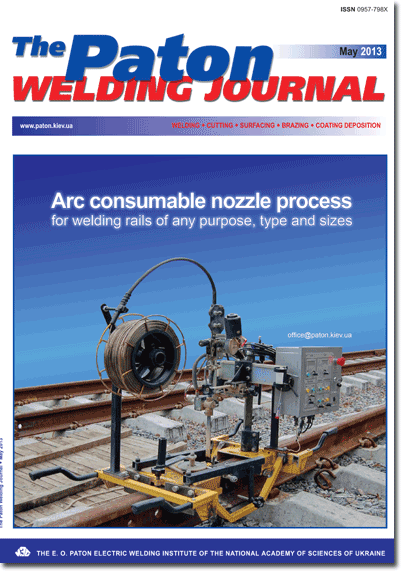| 2013 №05 (09) | 2013 №05 (02) |

The Paton Welding Journal, 2013, #5, 2-13 pages
HYDROGEN-INDUCED COLD CRACKS IN WELDED JOINTS OF HIGH-STRENGTH LOW-ALLOYED STEELS (Review)
I.K. POKHODNYA, A.V. IGNATENKO, A.P. PALTSEVICH and V.S. SINYUK
E.O. Paton Electric Welding Institute, NASU, Kiev, Ukraine
Abstract
Possibility of development of hydrogen-induced cold cracks in welded joint depends on series of interconnected and complex physical phenomena. Work represents a short review of investigations carried out in the E.O. Paton Electric Welding Institute on study of processes of hydrogen absorption by metal, its diffusion in the welded joint considering kinetics of temperature gradient, hydrogen traps and residual stresses. Peculiarities of hydrogen diffusion in strain-free and plastically deformed metal were studied by experiment-calculated methods. Results of experiment-calculation investigations and mathematical modelling of mechanisms of generation and growth of hydrogen-induced cracks in welded joints on micro- and macrolevel are stated. It is shown with high reliability that interaction of hydrogen with dislocations makes the basis of mechanism of hydrogen embrittlement. Hydrogen influences nucleation and growth of microcracks in metal making coalescence of dislocations easier that result in localizing of plastic strain under effect of hydrogen. As it is showed by computer modelling of development of microdefects in metal, the reduction of grain size, at other factors being equal, increases metal sensitivity to negative influence of hydrogen. Mechanism of crack growth in metal containing hydrogen is proposed considering effect of hydrogen-enhanced localized plasticity. 64 Ref., 12 Figures.
Keywords: brittle fracture, hydrogen embrittlement model, hydrogen-enhanced localized plasticity, residual stresses, BCC metals, grain size, hydrogen diffusion
Received: 27.03.13
Published: 28.05.13
References
1. http://www.worldsteel.org
2. Pokhodnya, I.K., Yavdoshchin, I.R., Paltsevich, A.P. et al. (2004) Metallurgy of arc welding. Kiev: Naukova Dumka.
3. Beloglazov, S.M. (1975) Hydrogenation of steel in electrochemical processes (Review). Leningrad: LGU.
4. Kasatkin, O.G. (1994) Peculiarities of hydrogen embrittlement of high-strength steels in welding (Review). Avtomatich. Svarka, 1, 3-7.
5. Yukhnovsky, P.I., Tkachev, V.I. (1987) About state of hydrogen in metal. Fiz.-Khimich. Mekhanika Materialov, 4, 107-108.
6. Shvachko, V.I. (2002) Reversible hydrogen brittleness of bcc iron alloys Е structural steels: Syn. of Thesis for Dr. of Phys.-Math. Sci. Degree. Kharkiv.
7. Teus, S.M., Shivanyuk, V.N., Shanina, V.D. et al. (2007) Effect of hydrogen on electronic structure of fcc iron in relation to hydrogen embrittlement of austenite steels. Phys. Status Solids A, 204(12), 4249-4258.
8. Gavriljuk, V.G., Shivanyuk, V.N., Shanina, B.D. (2005) Change in the electron structure cause by C, N and H atoms in iron and its effect on their interaction with dislocations. Acta Materialia, 53, 5017-5024.
9. Pokhodnya, I.K., Shvachko, V.I. (1997) Physical nature of hydrogen-induced cold cracks in welded joints of structural steels. Avtomatich. Svarka, 5, 3-12.
10. Pokhodnya, I.K. (1998) Problems of welding of high-strength low alloy steels. In: Current materials science of 21st century: Transact. Kiev: Naukova Dumka, 31-69.
11. Geld, P.V., Ryabov, R.A. (1974) Hydrogen in metals and alloys. Moscow: Metallurgiya.
12. Kolachev, B.A. (1985) Hydrogen brittleness of metals. Moscow: Metallurgiya.
13. Yavdoshchin, I.R. (1969) Investigation and development of universal electrodes with rutile coating: Syn. of Thesis for Cand. of Techn. Sci. Degree. Kiev.
14. Pokhodnya, I.K., Shvachko, V.I., Portnov, O.M. (2000) Mathematical modelling of absorption of gases by metal during welding. The Paton Welding J., 7, 11-16.
15. Pokhodnya, I.K. (2003) Mathematical modelling of processes of interaction of metal with gases in arc welding. Ibid., 2, 2-9.
16. Pokhodnya, I.K., Portnov, O.M. (2003) Mathematical modelling of absorption of gases by electrode drop metal. Ibid., 6, 2-5.
17. Pokhodnya, I.K., Portnov, O.M., Shvachko, V.I. (2001) Computer modeling of hydrogen absorption by electrode metal drop under its intensive evaporation. In: Proc. of 6th Seminar on Numeric Analysis of Weldability (Graz, Oct. 2001). Graz: TU of Graz, 895-902.
18. Pokhodnya, I.K., Shvachko, V.I., Utkin, S.V. (1998) Calculated assessment of hydrogen behavior in arc discharge. Avtomatich. Svarka, 9, 4-7.
19. Pokhodnya, I.K., Tsybulko, I.I., Orlov, L.N. (1993) Influence of slag composition on hydrogen content in liquid metal during CO2 welding. Ibid., 11, 8-14.
20. Tsibulko, I.I. (1993) Calculation of thermodynamic equilibrium in metallurgical system gas-slag-metal. In: Proc. of 2nd Int. Seminar on Numeric Analysis of Weldability (Graz-Segau, 10-12 Sept. 1993). Graz: TU of Graz.
21. Pokhodnya, I.K., Shvachko, V.I., Ustinov, V.G. et al. (1972) Mass-spectrometric examinations of fluorides emitted in arc welding. Avtomatich. Svarka, 6, 10-12.
22. Pokhodnya, I.K., Shvachko, V.I. (1981) Formation of hydrogen fluoride in arc discharge. Ibid., 2, 11-13.
23. Pokhodnya, I.K., Paltsevich, A.P., Yavdoshchin, I.R. (1986) Influence of methods of weld metal sampling for determination of diffusion-mobile hydrogen content in it. Ibid., 1, 24-28.
24. Pokhodnya, I.K., Paltsevich, A.P., Yavdoshchin, I.R. (1988) Influence of welding conditions on hydrogen content in welds made with electrodes of basic type coatings. Ibid., 3, 19-22.
25. Paltsevich, A.P. (1999) Chromatographic method of hydrogen content evaluation in electrode coating components. Ibid., 6, 46-48.
26. Pokhodnya, I.K., Paltsevich, A.P. (2003) Examination of potential content of hydrogen. In: Abstr. for Int. Conf. on Current Problems of Welding and Resource of Structures (Kiev, 24-27 Nov. 2003). Kiev: PWI, 67.
27. Panasyuk, V.V. (1991) Mechanics of quasi-brittle fracture of materials. Kiev: Naukova Dumka.
28. Paltsevich, A.P. (1988) Development of methods of hydrogen content reduction in welds for new coated electrodes and flux-cored wires of basic type: Syn. of Thesis for Cand. of Techn. Sci. Degree. Kiev.
29. Pokhodnya, I.K., Demchenko, L.I., Paltsevich, A.P. et al. (1976) Kinetics of diffusion redistribution of hydrogen between weld metal and base metal in arc welding. Avtomatich. Svarka, 8, 1-5.
30. Pokhodnya, I.K., Demchenko, V.F., Demchenko, L.I. (1979) Mathematical modeling of gas behavior in welds. Kiev: Naukova Dumka.
31. Pokhodnya, I.K., Pavlyk, V.A., Shvachko, V.I. (1993) Effect of heat treatment and deformation on hydrogen diffusion and permeability of 10KhN3DM type steel. In: Metallurgy of welding and consumables. St.-Petersburg: StPGTU, 158-160.
32. (2011) Development of materials for welding of technological equipment of mining and smelting and fuel and energy complexes. Pt 1: Study by methods of experimental and numerical modeling of hydrogen behavior in weld metal of higher strength under conditions of thermal-deformation cycle of welding: Final report No. 0107U0022787. Kiev: PWI.
33. Sinyuk, V.S., Stepanyuk, S.N. (2009) Interaction of hydrogen with dislocation structure of structural steel welded joints. In: Proc. of Sci. Conf. on Mechanics of Fracture Materials and Strength of Structures (23-27 June, 2009, Lviv). Lviv: FMI, 999-1002.
34. Stepanyuk, S.M. (2001) Reversible hydrogen embrittlement in welding of high strength low-alloy steels: Syn. of Thesis for Cand. of Techn. Sci. Degree. Kyiv.
35. Shvachko, V.I., Ignatenko, A.V. (2007) Model of transportation of hydrogen with dislocations. The Paton Welding J., 2, 24-26.
36. Ignatenko, A.V. (2007) Mathematical model of transportation of hydrogen by edge dislocation. Ibid., 9, 23-27.
37. Pokhodnya, I.K., Shvachko, I.V., Kotrechko, S.A. et al. (1999) A new method for quantitative determination of sensitivity of steels to hydrogen embrittlement. Int. J. Mater. Sci., 34(4), 538-543.
38. Shvachko, V.I., Stepanyuk, S.M., Pokhodnya, I.K. (2000) The evaluation methods of HLSA steels susceptibility to hydrogen embrittlement. In: Proc. of 4th Int. Conf. on HSLA Steels (Xi`an, China, Oct. 30-Nov. 2, 2000). Beijing: Metallurg. Industry Press, 453-458.
39. Pokhodnya, I.K., Meshkov, Yu.Ya., Shvachko, V.I. et al. Method of quantitative determination of level of hydrogen embrittlement of structural steels and welds. Appl. 5040067. Int. Cl. G 01 n 17/00. Fil. 01.07.91.
40. Meshkov, Yu.Ya. (1981) Physical principles of strength of steel structures. Kiev: Naukova Dumka.
41. Meshkov, Yu.Ya., Pakharenko, G.A. (1985) Structure of metal and brittleness of steel products. Kiev: Naukova Dumka.
42. Meshkov, Yu.Ya., Serditova, T.N. (1989) Fracture of wrought steel. Kiev: Naukova Dumka.
43. Kotrechko, S.A., Meshkov, Yu.Ya., Mettus, G.S. (1990) To problem of tough and brittle states of polycrystalline metals. Metallofizika, 12(6), 3-13.
44. Sinyuk, V.S., Pokhodnya, I.K., Paltsevich, A.P. et al. (2012) Experimental study of the mechanism of hydrogen embrittlement of metals with the bcc lattice. The Paton Welding J., 5, 8-11.
45. Tsaryuk, A.K., Brednev, V.I. (1996) Problem of cold crack prevention. Avtomatich. Svarka, 1, 36-40.
46. Vladimirov, V.I. (1984) Physical nature of metal fracture. Moscow: Metallurgiya.
47. Birnbaum, H.K., Sofronis, P. (1994) Hydrogen-enhanced localized plasticity Е a mechanism for hydrogen-related fracture. Mat. Sci. and Eng. A, 174, 191-202.
48. Kotrechko, S.A., Meshkov, Yu.Ya. (2008) Ultimate strength. Kiev: Naukova Dumka.
49. Pokhodnya, I.K., Shvachko, V.I., Utkin, S.V. (2002) Effect of hydrogen on equilibrium of dislocation submicrocrack in a-iron. Fiz.-Chimich. Mekhanika Materialiv, 1, 7-14.
50. Beachem, C.D. (1972) A new model for hydrogen-assisted cracking (hydrogen embrittlement). Metallurg. Transact., 3, 259-273.
51. Gedeon, S.A., Eagar, T.W. (1990) Assessing hydrogen-assisted cracking fracture modes in high-strength steel weldments. Welding J., 6, 213-219.
52. Sofronis, P., Liang, Y., Aravas, N. (2001) Hydrogen induced shear localization of the plastic flow in metals and alloys. Eur. J. Mech. Е A: Solids, 20, 857-872.
53. Liang, Y., Sofronis, P., Aravas, N. (2003) On the effect of hydrogen on plastic instabilities in metals. Acta Materialia, 51, 2717-2730.
54. http://www.icf.11.com/proceeding/EXTENDED/5638.pdf
55. Liang, Y., Sofronis, P., Dodds, R.H. (2004) Interaction of hydrogen with crack-tip plasticity: Effect of constraint on void growth. Mat. Sci. and Eng. A, 366, 397-411.
56. Ahn, D.C., Sofronis, P., Dodds, R.H. (2007) On hydrogen-induced plastic flow localization during void growth and coalescence. Int. J. Hydrogen Energy, 32, 3734-3742.
57. Ignatenko, O.V., Pokhodnya, I.K. (2011) Influence of hydrogen-enhanced localized plasticity and grain size on the strength of bcc metal. In: Proc. of 2nd Ukrain.-Greek Symp. on Fracture Mechanics of Materials (3-7 Oct. 2011, Lviv). Lviv: FMI.
58. Ignatenko, A.V., Pokhodnya, I.K., Paltsevich, A.P. et al. (2012) Dislocation model of hydrogen-enhanced localizing of plasticity in metals with bcc lattice. The Paton Welding J., 3, 15-19.
59. http://dfmn2011.imetran.ru/2011/index.php
60. Ignatenko, O.V., Pokhodnya, I.K., Stepanyuk, S.M. et al. (2010) Principles of hydrogen cracking of welded joints of high strength low alloy steels. In: Fundamental problems of hydrogen energy. Kyiv: KIM, 340-360.
61. Ostash, O.P., Vitvittsky, V.I. (2011) Duality of hydrogen effect on mechanical behavior of steels and structural optimization of their hydrogen resistance. Fiz.-Chimich. Mekhanika Materialov, 4, 4-19.
62. Ignatenko, A.V., Sinyuk, V.S. (2012) Influence of hydrogen-enhanced localized plasticity and complex-stressed state on strength of metal. In: Proc. of 6th Int. Conf. on Mathematical Modelling and Information Technologies in Welding and Related Processes (Katsiveli, 29 May-1 June 2012). Kiev: PWI, 35-36.
63. Panasyuk, V.V. (1968) Ultimate equilibrium of brittle bodies with cracks. Kiev: Naukova Dumka.
64. Morozov, L.S., Chechulin, B.B. (1967) Hydrogen brittleness of metals. Moscow: Metallurgiya.
Suggested Citation
I.K. POKHODNYA, A.V. IGNATENKO, A.P. PALTSEVICH and V.S. SINYUK (2013) HYDROGEN-INDUCED COLD CRACKS IN WELDED JOINTS OF HIGH-STRENGTH LOW-ALLOYED STEELS (Review). The Paton Welding J., 05, 2-13.The cost of subscription/purchase order journals or individual articles
| Journal/Currency | Annual Set | 1 issue printed |
1 issue |
one article |
| TPWJ/USD | 384 $ | 32 $ | 26 $ | 13 $ |
| TPWJ/EUR | 348 € | 29 € | 24 € | 12 € |
| TPWJ/UAH | 7200 UAH | 600 UAH | 600 UAH | 280 UAH |
| AS/UAH | 1800 UAH | 300 UAH | 300 UAH | 150 UAH |
| AS/USD | 192 $ | 32 $ | 26 $ | 13 $ |
| AS/EUR | 180 € | 30 € | 25 € | 12 € |
| SEM/UAH | 1200 UAH | 300 UAH | 300 UAH | 150 UAH |
| SEM/USD | 128 $ | 32 $ | 26 $ | 13 $ |
| SEM/EUR | 120 € | 30 € | 25 € | 12 € |
| TDNK/UAH | 1200 UAH | 300 UAH | 300 UAH | 150 UAH |
| TDNK/USD | 128 $ | 32 $ | 26 $ | 13 $ |
| TDNK/EUR | 120 € | 30 € | 25 € | 15 € |
AS = «Automatic Welding» - 6 issues per year;
TPWJ = «PATON WELDING JOURNAL» - 12 issues per year;
SEM = «Electrometallurgy Today» - 4 issues per year;
TDNK = «Technical Diagnostics and Non-Destructive Testing» - 4 issues per year.


